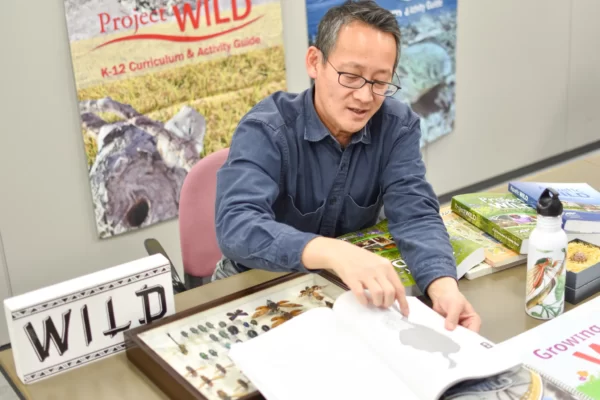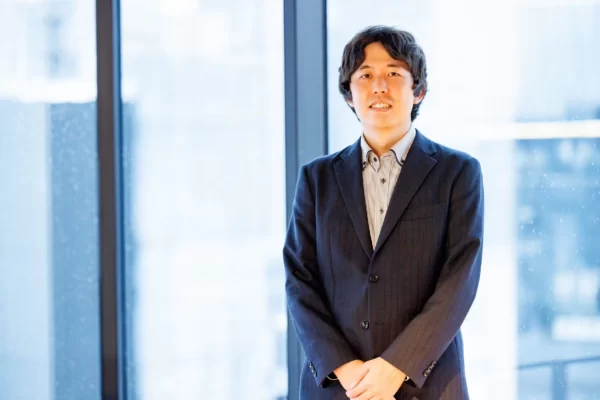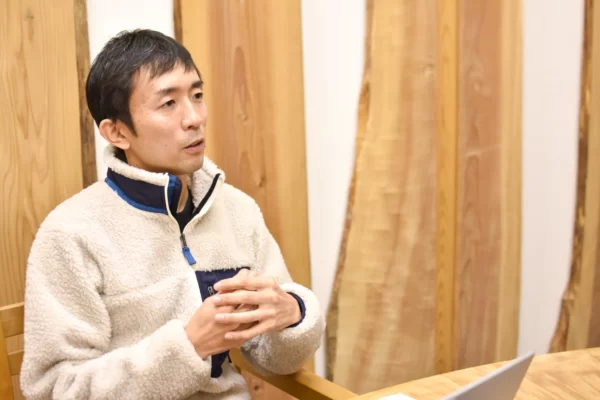Project WILD – An environmental education program to develop ‘people who can act for nature and the environment’(Education of Nature Conservation)
Project WILD is an environmental education program that fosters “people who can act for nature and the environment” through learning about the environment and wildlife at school in outdoor activities.
We interviewed Mr. Hiroshi Kawahara, who is the coordinator of Project WILD in Japan.
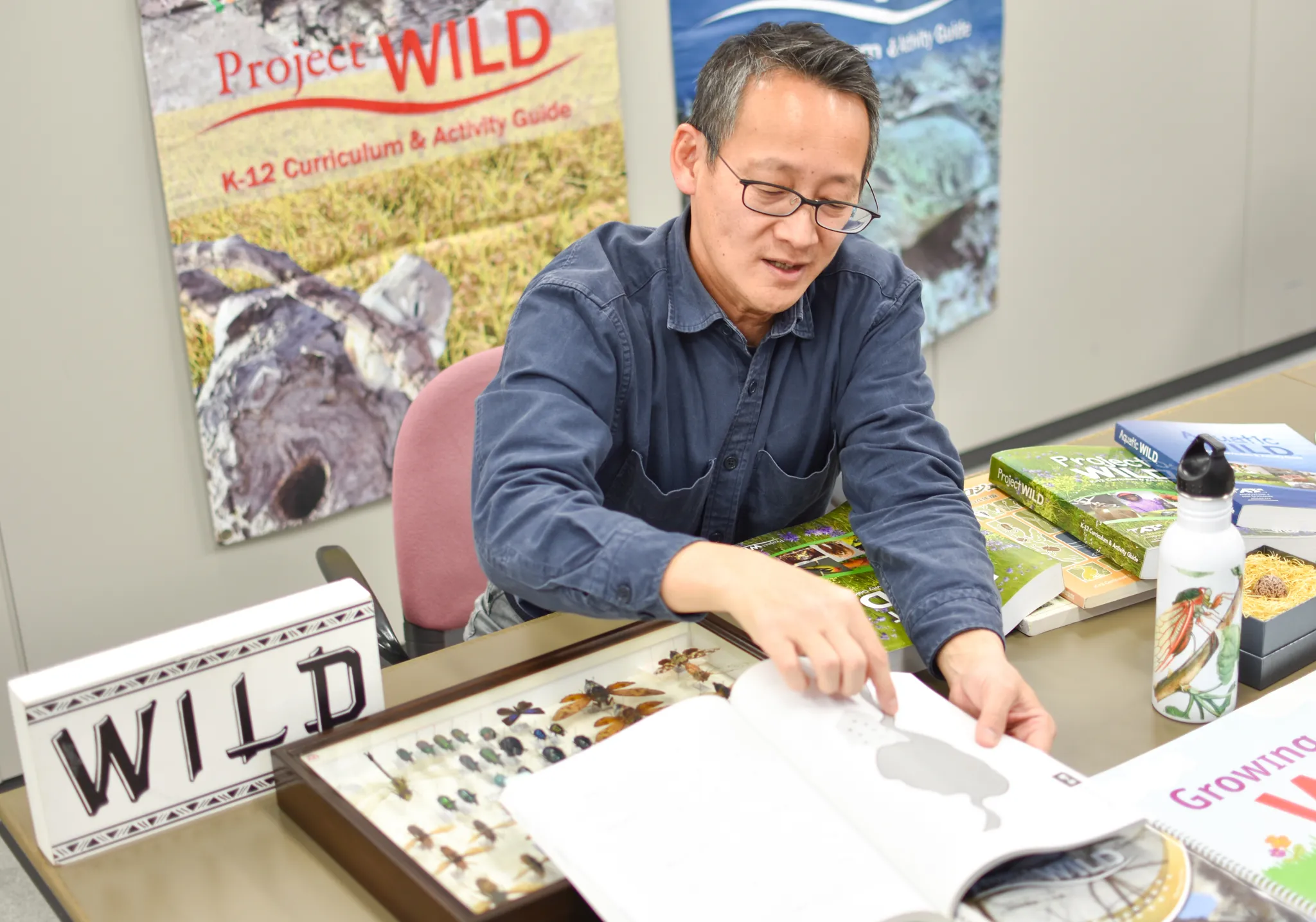
Project WILD Japan Representative Coordinator, General Manager, Environmental Education Promotion Office, Development and Research Department, The Park Foundation
Hiroshi Kawahara
Born in November 1967, he grew up in Nara from childhood to university. After graduating from the Faculty of Agriculture at Osaka Prefecture University, he went on to complete a master’s degree in landscape architecture at the same university.
During his master’s degree, he studied abroad at the Melbourne Institute of Technology in Australia.
He represents Japan at the annual Project WILD Coordinators Meeting held in the U.S., and has a network of contacts with The Association of Fish and Wildlife Agencies (AFWA) and coordinators in various states across the U.S.
Background of ‘Project WILD’, an environmental education program based in the U.S.
Please tell us about the origins of Project WILD and its activities.
Project WILD is an environmental education program based on the theme of WILD LIFE, working to nurture people who not only understand the importance of nature, but also can take action for nature and the environment.
Development of the program began with the cooperation of educators, people involved in environmental conservation and nature preservation, wildlife managers, and representatives of business and industry in various states across the U.S., and was completed in 1983, and its dissemination began in the United States, mainly by state governments.
From December 1999 to January 2000, the first Project WILD instructor training seminar was held in Japan. Since the program was introduced from the U.S., it seems that it attracted quite a lot of attention. Many environmental educators refer to this period as the “environmental education bubble”.
Although many of the textbooks developed at the beginning of the program focused on large mammals, the focus has now shifted to familiar creatures, such as insects.
The reason why the initial focus was on large mammals was due to the economy (money). America is a gun society, and even children enjoy hunting with their fathers. The target of hunting is large mammals such as deer and bears, which are called game animals. The huge amount of money involved, including hunting license fees, goes to the state government in the form of taxes. The power of money is great.
However, excessive hunting, overhunting, and habitat degradation have led to a sharp decline in the number of large mammals. When there are no more game animals to hunt, of course, the government no longer receives taxes. Officials were very worried.
In order to counteract this sharp decline the federal government took the lead in creating various rules for sustainable conservation and management. One of these was education.
This is why the Project WILD text focuses on large mammals. The same is true of the focus on commercially valuable species such as migrating salmon.
The U.S. version of Project WILD is revised every few years, and the current version focuses more on insects and other familiar creatures. I think this is evidence that adults are realizing the importance of children’s healthy development through full use of their five senses by being exposed to living things, and that attention to this issue is increasing.
Are textbooks used around the world?
When we introduced the textbooks to Japan, they attracted a lot of attention because it was the first program that came from the United States. It was also used around the world by interested university professors in Scandinavian Sweden, Canada, China, and Hong Kong, showing its expansion beyond the United States.
Currently, the program is used in four countries: the United States, Puerto Rico, Canada, and Japan. Other countries are believed to have developed their own programs.

There is one for young children, a bird section, an aquatic animal section, and a terrestrial animal section.
Sensing about ecological changes after studying insects for decades
The theme of CLASS EARTH is Nature Positive. Biodiversity is in a critical situation that needs to be restored, but do you have any sense that it is becoming more serious after having watched nature for so long?
When I was a child, I spent my summers collecting insects. I was truly an insect enthusiast. Some species that were commonplace in the past have become rare, and some species that were rare in the past are now common. I feel that habitat change and climate change have a great impact on the variance of insect populations.
From its clear wings and pitch-black body to its beautiful golden hair, the kuma-zemi was one of the cicada species that I admired. When I return to the countryside during summer vacation, I find it singing in the treetops of a tall zelkova tree on the temple grounds. Their transparent wings reflect the sun and make them appear white when you look up from below. The white wings look really cool against the pitch black body. I remember that I wanted to get my hands on a kuma-zemi so badly that I begged my father to make me a long insect net about 20 meters (65 feet) long by splicing several bamboo sticks together.
At that time, I was lucky if I could catch one or two kuma-zemi in a season, but now I can find 20 to 30 kuma-zemi per tree. The southern species of kuma-zemi is expanding its influence northward due to climate change.
This is what my father and mother told me, but the Nami-gengoro (Cybister, diving beetle), which is now feared to be extinct, used to be really abundant. If you looked into the deep puddles of water that flowed along the sides of rice paddies, you could observe many Gengorou floating around with their bottoms up.
Turtles, the reigning king of aquatic insects, were so plentiful that people were told to be careful when playing in the river because they could get caught in the water! It is now positioned as an endangered species II (Vulnerable species according to the IUCN endangerment scale). Habitat change (deterioration) is one of the major causes. It is the influence of human activities.
Japan should be more proud of its rich diversity.
Insects support ecosystems along the food chain, and while both Japanese and foreign ecosystems have their own unique characteristics, what do you think is unique about the Japanese ecosystem?
Biodiversity, without a doubt. Japan has an amazing diversity of environments.
The diversity of habitats means that there are many species of living creatures.
Japanese people need to know more about this wonderful natural environment of which Japan is proud. We should be proud and feel proud of it.
How do you communicate with children about the splendid and importance of diversity?
For example, when I ask children, “How many species of stag beetles do you think there are in Japan?”. Children who know well answer about 10 species. In reality, there are about 50 species, and if you include subspecies, the number exceeds 100.
The reason why there are so many is because of the diversity of environments. They range from cool Hokkaido to the alpine zones of central Honshu and as far south as Yonaguni Island.
It is important to have a proper knowledge of living creatures and nature. Knowledge is important. Knowledge enables us to make correct judgments, and from this knowledge, various ideas are born.
Project to develop “people who can act for nature and the environment” with fun activities.
I see that the text covers a wide range of creatures, not only insects and animals, but also birds and sea creatures. I think that there are not only endangered species, but also creatures that have struggled with survival due to environmental changes. Are there any programs that would be useful in educating people about such things?
For example, how about a card game like this?
This is not about answering the correct answer, but rather about letting people think freely from the picture.
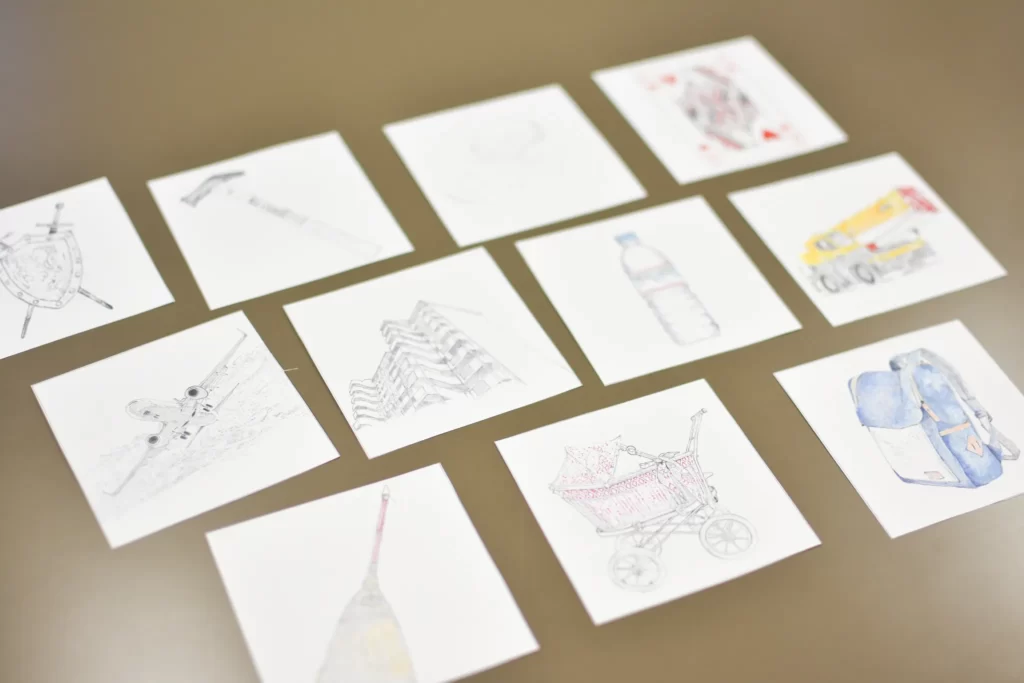
For example, if the card is a “backpack,” the player can think of “an ant must carry a lot of food, right? Kawahara himself drew the pictures on these cards.
Then there is the most popular program called “Dragonfly Pond for Everyone.“
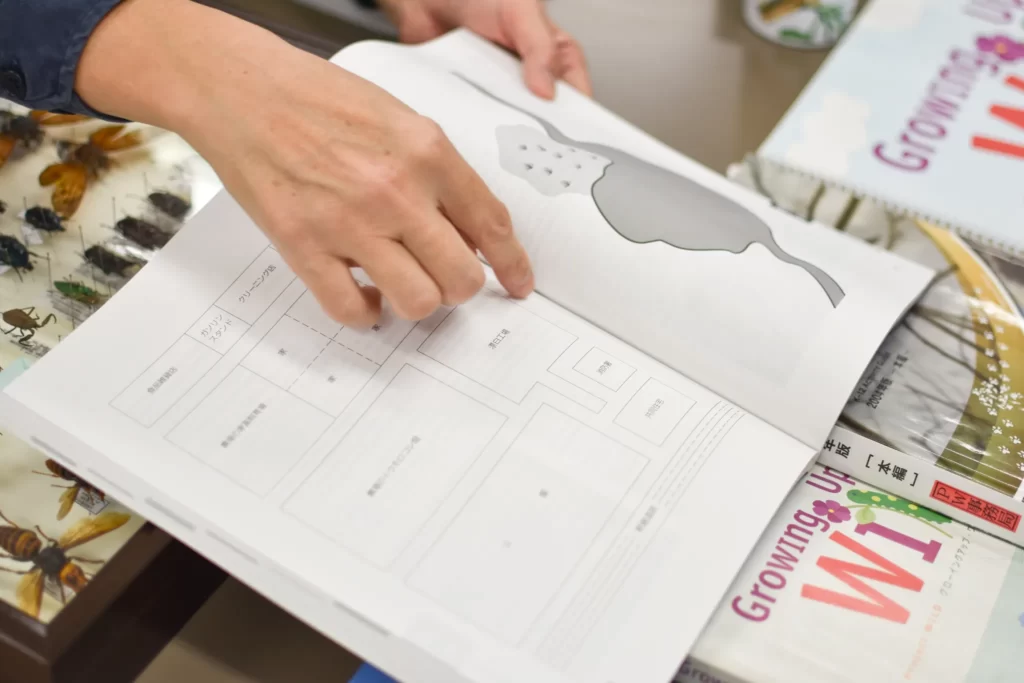
The placement of buildings, etc., was discussed so that all teams could agree on the layout.
Most teams then build houses where clean water flows upstream and factories downstream. This is a natural arrangement considering the impact on the people living upstream.
However, what if we connect the cities of each team?
The houses that would have been upstream would be on the other team’s downstream of the river…
It is not enough to be good only in your own place (region). It is clear that everything is connected and influences each other.
In this Dragonfly Pond, we are taking it to the point where, “Eventually, the river water will reach the ocean. And the ocean is connected to the whole world, right?”
It is not enough to think only about ourselves; it is important to have a global perspective.
Nowadays, human beings have too much power and influence over many things. If that is the case, we, the people who have the power, need to think and act more wisely. We need to think from a broader perspective.
It is difficult to experience circulation in a short time, but it is easier to understand and remember when experienced while having fun in a workshop or other playful environment.
There are many other programs in Project WILD that are not simulated experiences, but rather simulations in which you become a living creature.
One of them is the Sugoroku game, in which you try to pretend to be a migratory bird.
While playing Sugoroku, a game that tells the story of migratory birds, you can feel how hard it is to cross and learn more about migratory birds.
For example, migratory birds travel long distances. To let you feel how hard it is, there is a scene in the Sugoroku mission where you have to flap your hands up and down for a few minutes. Flying is really hard work. Few birds can reach their destination even after a lot of hard work. Many of them die before reaching their destination. In fact, it is said that only 20 to 30% of migratory birds make it to their southern wintering grounds.
In connection with the bird, do you come up with down vests, down coats, etc., which we also discuss in our apparel products ?
Some of the texts in the Terrestrial Animals sections are about buying and selling wildlife (fur and down). This program makes us think about the fact that our affluent lives are made possible by the benefit of wild animal life.
We would like to think about animal welfare as we make things in the future. It is a matter of course not to use things that should not be used, but we would like to think about how to make products that will improve the ecosystem through our use. To achieve this, we believe it is important to learn properly.
The ultimate goal of Project WILD is to develop people who can take action, not just knowledge and information. It is not so easy to be able to take action. I myself sometimes wonder if I am still taking good care of nature. Educating people means that I have to keep learning.
The diversity of species means that there is such a splendid environment.
Children naturally learn through fun activities.
CLASS EARTH is based on the motif of endangered species, but I think that Project WILD is not only working to conserve endangered species, but also to balance the overall population. How do you think children can learn about biodiversity and understand its importance?
I often talk to children about the importance of the existence of various living things.
In a world where there are various relationships, such as eating, being eaten, symbiosis, parasitism, etc., only those that win the competition survive. A single species is unstable and prone to collapse. It is the complex intertwining of various living creatures that creates a stable ecosystem.
Although this is a bit of a departure from the living creatures, languages are also decreasing rapidly at present.
Tribes are disappearing and minority languages (tribal languages) are disappearing rapidly. The reason you see so many “snow” languages in the languages of tribes living in cold regions is because they need them to survive. Accurately communicating snow conditions to one’s peers can help one avoid many dangers. In extreme cases, if the languages of the world were unified into just one language, it would not be interesting at all. It is precisely because there is diversity that many different ideas are born.
In terms of the need for survival. I believe that language is very similar to biodiversity, that it is necessary for survival and also that we can learn and enrich ourselves because of the diversity of our environment.
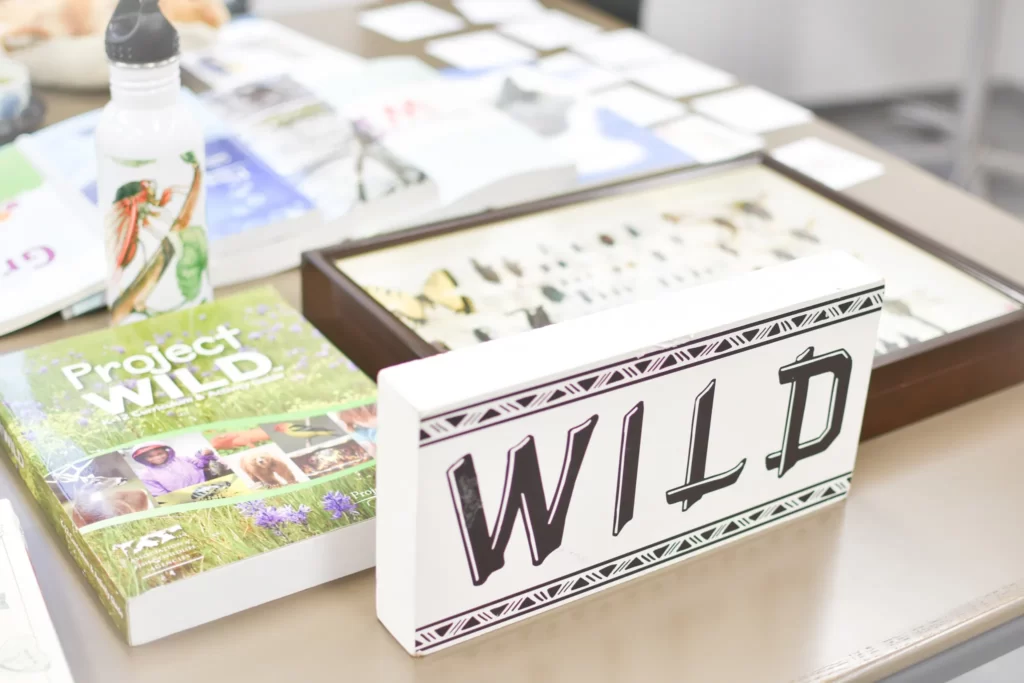
What we adults can do to help people realize that we are in the loop of biodiversity.
We, the members of CLASS EARTH, originally worked only with insects, but we felt that it was too fragmented as a learning experience.
Project WILD, which offers a wide range of learning, has been a guiding light for us.
What role do you think education will play in promoting Nature Positive in the future? What is the potential of nature education in the conservation and restoration of biodiversity?
I believe that if more people become interested in real living things, it will definitely lead to a greater respect for biodiversity.
We must make sure that the next generation will not say, “This is what the people of that era did, and this is what the earth has become. For the sake of our children, who are the future, we need to become more knowledgeable and take the right actions.
I would like to invite both children and adults to experience real-life animal husbandry.
Through husbandry (real-life experience), children learn in many ways.
When I was a child, I used to feed my stag beetle by tapping the rearing case three times before continuing to feed it. It was not my intention, but before I knew it, when I tapped the case, the stag beetle began to squirm out from under the sawdust. They began to understand the signal to feed. Even stag beetles are learning. I believe that animal husbandry is both a love and a learning experience.
The more living things you come into contact with, the more you learn about nature, the more fun, beautiful, and most interesting it is. However, we do not impose this idea on children. It is important for us adults to provide more and more opportunities for various nature experiences. Children will learn and deepen their own learning through various experiences. Is it fun or not? Are they interested or not? It is up to the children themselves to judge and decide.
The natural environment is changing, and we adults must continue to learn as well.
I don’t want to forget the emotions and excitement I feel when I come into contact with nature, even as an adult, and I want to continue to cherish them. I would like to become a “big kid!”.
About CLASS EARTH
What is your impression of CLASS EARTH?
I can feel the straight and firm thoughts from people like CLASS EARTH who are sincerely trying to do their best. If more people become interested in real living things, it will definitely lead to respect for biodiversity.
And if you tell children to “think about it in a fun way,” they will naturally turn their attention in that direction because they are smart. I feel that this is exactly what CLASS EARTH’s activities themselves are aiming for. That is why I support you wholeheartedly.
We will do our best to pass on the message to parents and children as well, and would be happy to work with you and Project WILD on a workshop where we can learn how to love living things from a teacher who loves living things.
Project WILD
https://www.projectwild.jp/

